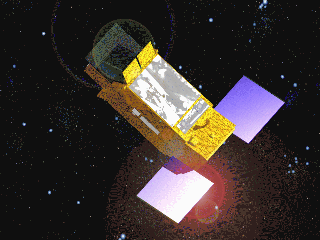

Mission Status Report #58 Star Date: May 28, 2002 Caption: Graphic representation of FUSE on orbit. (Graphic provided by CSA.) (Click image above to see a larger version.)
FUSE Capabilities Continue ExpandingThe FUSE satellite continues to operate well after our recovery from Reaction Wheel problems. With each passing week, we are also learning more about our new control system and how it behaves both for slewing (moving between targets) and for static pointing stability. Since the recovery, we have been restricted to observing targets at absolute declinations (or celestial "latitudes" if you will) higher than 40 degrees (that is, above +40 degrees in the north or below -40 degrees in the south) in regions where we can keep FUSE pointed stably during science observations. During the last month, we have demonstrated observing strategies that have allowed us to successfully observe two targets well below 40 degrees declination, in the zone that is unstable much of the time. Using new software that predicts temporary regions of stability, we observed targets at declinations of 23 and 8 degrees! Each target was observed several times over the course of a week as part of a monitoring program for a Cycle 3 Guest Investigator program. This is a great step forward in our attempt to return FUSE to full-sky coverage. With the current capability and understanding, we can now access about 75% of the celestial sphere at one time or another during the year! (This is up from about 40%.) We now need to take what we have learned from these initial attempts and incorporate it into our planning software to make scheduling these observations more standardized. Also, we have other ideas to test out that will no doubt open things up further. We are extremely pleased with progress to date. As further evidence of the robustness of operations, I recently pulled together a summary of performance of the mission since February 1, 2002 (just after operations were restarted). I am pleased to tell you that we have observed over 300 new science targets during this time, for a total of over 4 million seconds of science exposure time! Our science efficiency (on target time compared to the wall clock) over this time has been 35%, compared with a mission average 28% prior to December 2001. This is excellent performance for a low earth orbit mission, and clearly demonstrates the effects of being forced to observe primarily at high declinations where visibility intervals a longer on average. Hence, while this efficiency number may drop some as we start incorporating more low declination targets, it is still very important for us to maximize the target availability at higher declinations to maximize the scientific return from FUSE. On another front, the semi-annual American Astronomical Society meeting is next week in Albuquerque, NM. Over 25 FUSE-related presentations are on the docket for that meeting, including a series of talks about the FUSE recovery effort. If you attend the meeting, I hope you can come to that session and hear more details about the process we have been through. It has been (and continues to be) an amazing story. Reported by: Bill Blair, Chief of Observatory Operations
|
